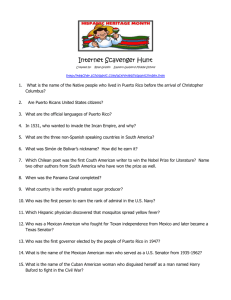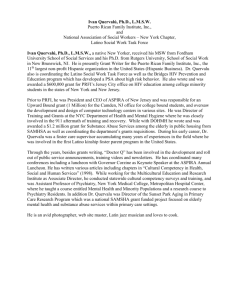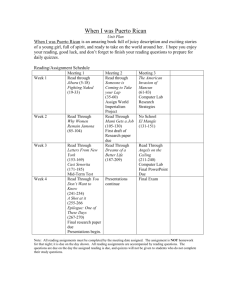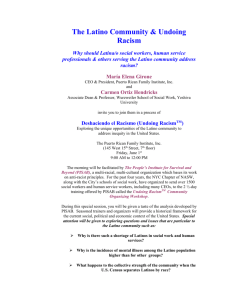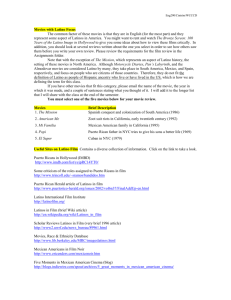The Origins and Evolution of Latino History
advertisement
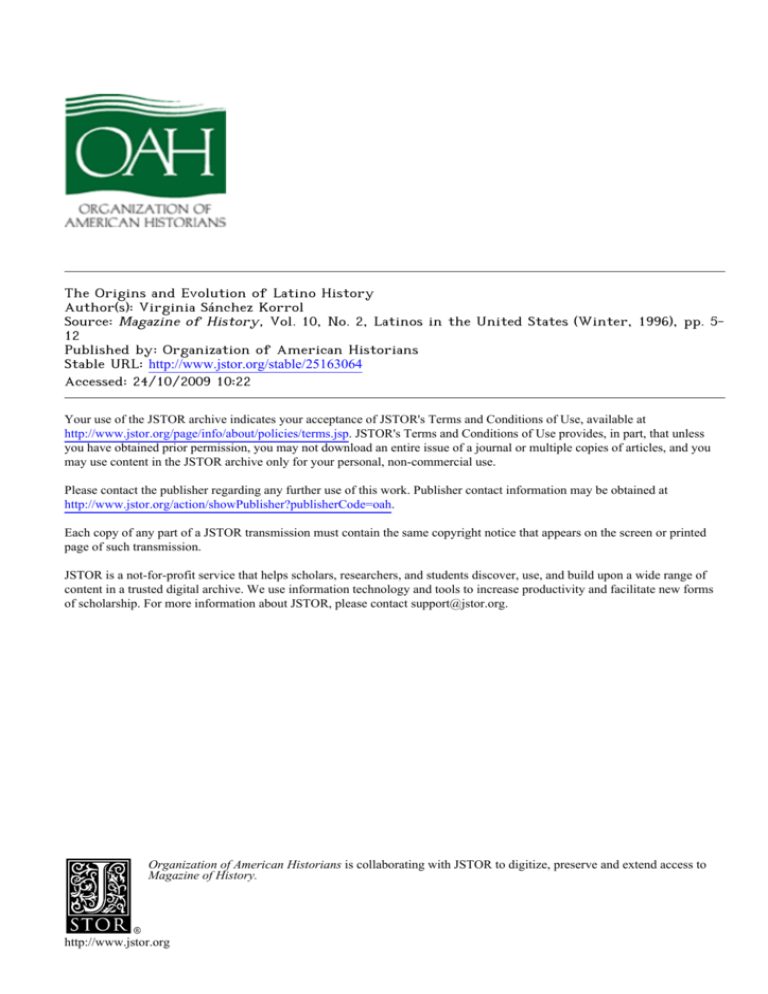
The Origins and Evolution of Latino History Author(s): Virginia Sánchez Korrol Source: Magazine of History, Vol. 10, No. 2, Latinos in the United States (Winter, 1996), pp. 512 Published by: Organization of American Historians Stable URL: http://www.jstor.org/stable/25163064 Accessed: 24/10/2009 10:22 Your use of the JSTOR archive indicates your acceptance of JSTOR's Terms and Conditions of Use, available at http://www.jstor.org/page/info/about/policies/terms.jsp. JSTOR's Terms and Conditions of Use provides, in part, that unless you have obtained prior permission, you may not download an entire issue of a journal or multiple copies of articles, and you may use content in the JSTOR archive only for your personal, non-commercial use. Please contact the publisher regarding any further use of this work. Publisher contact information may be obtained at http://www.jstor.org/action/showPublisher?publisherCode=oah. Each copy of any part of a JSTOR transmission must contain the same copyright notice that appears on the screen or printed page of such transmission. JSTOR is a not-for-profit service that helps scholars, researchers, and students discover, use, and build upon a wide range of content in a trusted digital archive. We use information technology and tools to increase productivity and facilitate new forms of scholarship. For more information about JSTOR, please contact support@jstor.org. Organization of American Historians is collaborating with JSTOR to digitize, preserve and extend access to Magazine of History. http://www.jstor.org The Latino History Virginia am new. History made me. My I Aurora Levins Morales "Child of the Americas"(l) Spanish pueblos, Americas As among thirty million States, matches form a core of recent relatively some a union arrivals, that long-time U.S. residents; pre English ethnic ing with Spanish speaking; aliens with individuals citizens; and documented with undocumented immigrants. As the nation's fastest growing "minority," all indicators point to a heightened sense of across ethnic and a collective ing national lines, consciousness lines, tive histori cal role in the U.S. The validation of memory, role in the U.S. self-iden and affirmation tification, contestation, as centuries spans persons of Spanish American heritage have always figured in themaking of theUnited States of America. before the massive migrations and immigra tions of the present. The forgotten heritage of Hispanics inwhat is now theUnited States forms the focus of contemporary historical and literary investigation (2). theatrical works, and narratives, sources primary gia, Texas, Carolina, form Arizona, other ex earliest the South Louisiana, Missis Missouri, California, Kansas, sippi, Arkansas, islands. panic Caribbean a strong web of and Alabama, and include as well Nebraska, the His reveal Sources interconnec regional tions that linked the Hispanic Caribbean and South and Central America with U.S. communities, one point ~~ aiding to another. commercial, major from migration The founding and religious, of cul tural sites?among them the cities of Los Angeles, Santa Fe, St. Augustine, San one hundred years, the origins of a compre hensive Latino/Hispanic entity began well and travel poetry, civil, musi records, m tant literature inwhat is today the United States. A wealth of materials, including oral traditions, chronicle multifaceted life in colonial settlements from the six teenth to the nineteenth centuries inwhat are presently Florida, New Mexico, Geor receptiv across Latinos regardand rich a collec regarding consciousness and historical ecclesiastical cal compositions prose, lines and national ~~ and diaries chronicles, administrative, testimonials, military, and ity among speak awareness and receptivity among Latinos the nation's awareness dominantly from the Dominican Repub lic and Central and South America, with Spanish American and settlements, villas, presidios, and missions the throughout pre-date Jamestown by at least fastest all growing "minority/' to a indicators point sense heightened of in the United Hispanos the of population Korrol ? Mexican Americans/Chicanos, and Puerto Ricans, Cuban Americans, their descendants, the oldest and largest sub-groups Sanchez Viewed from another perspective, as Na tive Americans, Latinos were there when As Plymouth Rock was just a pebble. first language was spanglish. Iwas born at the crossroads and Iam whole. of Evolution and Origins Antonio, and San to Juan?testify the vitality of a period that set standards for enduring socio-cultural institutions and wove the earliest connecting strands among Spanish Americans. The nineteenth century brings into focus the formation of peoplehood. This a initiates rich of docu period tapestry OAH Magazine of History Winter 1996 5 from the regional presses that bridged peripheral northern communities inMexico with the southern metropolis mentation City, els, or Havana, or San testimonios, essays, Juan, to the and treatises nov of political exiles. The first historical novel ever written in the United States might well have been Jicotencal, penned by in Philadelphia in Cuban Felix Varela 1826 (3). Along with other literary ef forts, Varela's work serves to illustrate the na earliest ideas about Latin American tionhood. It is significant also that the first to emerge Spanish language newspaper El from U. S. Hispanic communities, in New Orleans in Misisipi, published 1808, initiated a long chain of periodicals that afford the historian intimate glimpses of into the ethos of large communities to who Americans speak and happened write in Spanish (4). By the time the Treaty of Guadalupe terri Hidalgo ceded half of the Mexican Mexican to States in the United 1848, tory heritage had become inextricably woven '""""-"" " ____ into the historical fabric of the American As they assessed their situa Southwest. tion in the "uneasy space that marked the intersection of the cultures of Mexico and the United States," Mexican Americans struggled with issues of identity in the decades following 1848 (5). Their con cerns were expressed inwriting in dozens of Spanish language newspapers that dot in folkloric border ted the Southwest, corridos that extolled the virtues of folk or Juan heroes like Gregorio Cortez Chacon, in the actions of rebels like Joaquin and in and Tiburcio Vasquez, like Mariano Vallejo's autobiographies that served as a form of cultural resistance. Viewed also through the lens of the landed elite, novels like Maria Amparo Ruiz de Burton's The Squatter and the Don testify to a chaotic world of clashing Anglo and Murrieta Mexican as values conclusion (6). On the other late-nineteenth and century side of __ . neared its the continent, early-twentieth and Puerto tury Cuban i i, the Rican cen political Courtesy of HunterCollege, CUNY exiles, joined by expatriates from South and Central America, articulated an agenda concerns in the Spanish of working-class language presses of southern Florida and New York City. Confronting oppressive colonial structures and the economic dev astation 11 ^____tf'4___f^ _ jfe jiippMBBM-B.i.'.,?..A DELBRONX "I ii^H __m^^^^^^^^^^^^^H ??- - ______-__._-_-_-,-__.-_... mum^-'^m^tm^^^^^^^^^^^^^^^^^^^B^^^^mli^^^BKl^^^^^^^^^^M the ten-year war, extensions of the spearheaded cigar industry in Tampa, Ybor City, and New York City, providing the that locus for working-class emigrations twentieth would continue into the century. Strategies of Antillean independence, radi cal labor organizing, and even the seeds of Puerto Rican feminism were sown; the latter especially with the second edition Mi of Luisa Capetillo's publication Disecatacion las libertades sobre opinion: de la mujer in Ybor City (7). Under leaders like Jose Marti, Fran cisco Gonzalez (Pachin) Marin, and Sotero Figueroa, "The Bases of the Cuban Revo lutionary Party" were written and ratified by supportive groups in New York, New and other revolu Orleans, Philadelphia, centers throughout the Americas. tionary These ideologies were well known outside and within exile communities composed of racially diverse work predominantly men ing-class ... l|#__ by wrought Cubans island's views on the and women. social and Progressive economic contra found within their communities appeared in the pages of Patria, the revo lutionary organ, and others like El Latino Americano or El Porvenir (8). the Spanish Cuban Ameri Following canWar, focus shifted from independence dictions to internal community concerns, includ inmutual of workers the ing organization aid societies, unions, and other supportive associations. Women emerged promi nently among the union ranks, and could be found at the forefront of workers' In New York, essayists?in struggles. ____________________kJ__i___________________________ cluding Cuban Alberto O'Farrill, editor of the weekly, Grdfico\ Puerto Rican Arturo of the Alfonso Schomburg, bibliophile in the African Americas; experience and Jesus Bernardo Vega, chronicler; as well as columnist for Justicia, Colon, Bronx 6 Hispanic American Registration OAHMagazine ofHistory Committee, November Winter 1996 1956. their communi other papers?defended ties against American foreign and domes In so doing, they tic imperialism (9). followed a tradition set forth by leading nineteenth-century Antillean thinkers who lived and wrote in New York. Included the among this group were Jose Marti, tural affirmation and bilingual innovation in their creative expression. Listed among this group are Rodolfo "Corky" Gonzalez' s Yo Soy Joaquin/1 Am Joaquin; Tomas father of the Cuban independence, and Maria de of educator the Hostos, Eugenio These intellectuals, in particu Americas. Rivera's a concept lar, supported of Hispano-Ameri can unity and were acutely aware of their historical place within the Ibero-Ameri can family. fifty years, a handful of pio intellectuals, writers, and other neering the condition with pensadores grappled and status of Latinos, especially Mexican Americans. Conditioned by the political tone and generation in which they were produced, their contributions proposed to Within mediate, validate, fine theMexican or Cuban U.S. and, rede ultimately, Puerto Rican, American, In the produc experience. tion of new knowledge, the academics stereo attempted to eradicate debasing to confront and types racism and discrimi nation. Among the first scholars to fashion aMexican American identity were histo rian Carlos E. Castaneda, sociologist George I. Sanchez, and folklorist Arthur I. Cultural Campa. definition, and the stirrings colonialism, sub-altern status concerning farm epic about Mexican workers, American Rudolfo Anaya's validation of oral tradi tion and the transmission of culture (13). It is within this climate of provocative, probing, and often militant activism that Juan Gomez Quinones issues his influen essay on culture and resistance, and gender, ethno-racial and new nary methods, perspectives, dynamics, intergenerational labor, interdiscipli categories of analy the demeaning, they challenged distorted, and monolithic interpretations of the U.S. Latino experience. Scholars mined the sources documenting the ori And the Earth did not Part; Ernesto Galarza's ethnographic autobiography, Barrio Boy: The Story of a Boy's Accul turation; and the classic, Bless Me Ultima, tial strong national connections, sis, la tierraf trago ...ynoselo elude "On Culture" (14). Today, these works are viewed as foundational, the first among several building blocks preserving and shaping contemporary Latino ideology. The onset of the 1970s and 1980s propagated a generation of historians and other academics schooled in the struggles for civil rights in the turbulent 1960s and influenced by the creative expression of their communities. Intent on expanding the boundaries of academic history to in gins and evolutions of Latino communi ties, unlocking a wide range of materials to new interpretations, sometimes build ing often upon?more and frontier, contesting?the cornerstones intellectual area of borderlands, Their studies. genera tion questioned Anglo American hege mony over historical interpretation and their domination of the historical research agenda (15). Not satisfied with merely creating "knowledge for the sake of knowl edge," their goals ranged from charting courses innovative to "set the record and methods straight," ing social histories that served to reconstruct important in and of themselves. The academic generation of the sev enties and eighties sought to reconstruct nineteenth- and twentieth-century diaspora Courtesy of HunterCollege, CUNY self ^_ racism, ethnicity, of U.S. Hispanos in other camps as well (10). Identity and affirmation were at the core of literary works written in Latin the America, Hispanic Caribbean, and the United States. In this vein, the works of Octavio Paz delve into theMexican psyche both north and south of the Rio Grande. The articles of Mario Suarez which estab II concepts of a lish post World War Mexican American identity are reflected on the East Coast inPuerto Rican Bernardo surfaced (11). The decade of the Vega's memoirs sixties witnesses the publications of en Guillermo Cotto Thorner's Tropico Piri Thomas's Down These Manhattan, Mean Streets, and Jesus Colon's A Puerto Rican in New York and Other Sketches. All works describe themigration and harsh conditions in the barrio hispano (12). Similar concerns emanated from Chicano writers as they grappled with the bitter ness of racism. They strove toward ____________EK_ii % ^JUlI _______H:_______________K__li'?' w 1 sir -i_________^________['::: ___________ League iWf_____PMPII^^^^^^^^^^^B____. It*Jilt:'J_F^11__11P11^ Si ?Jr__ of Puerto Rican Hispanics, A ^M _ii_i_l_Pwir___^_______________________H T 1* W^^^KSKSKKKKKl^^mm':'Wk **^ ?^ __^__________________________l _______B * * ^y* j*^^^ ^^SjP^ ___.___ JM?" _____ Brooklyn, New York. cul OAH Magazine of History Winter 1996 7 on Latinos/Hispanos?Albert cations Camarillo's Latinos in the United States is a case in point?to appreciate the scope of in all of their ethno-racial, communities Incor class, and gendered complexities. porating popular culture and written and oral traditions, these academics redefined the parameters ofthe new social history in and, the ^^_^_ ^^_^__^_^__. ^^^^^ ^^^^^ ? ^^?- industry, commercial communities Latinos, ^V^f^^^^^^^^^H^^^^^^^^^^^^^^^^^^^^^BB |^^^n^^^^|9Kilii^^^': leadership and insti Examples abound of the semi nal work produced by this generation, bring including the frontier studies of David the inter Weber; generational focus of where stage theirreality contrasted the and contested dominant Anglo ex perience and where they interacted within and across class lines ethno-racial and riers, with parts across tional na was and Latin America i II If IS^Klb 1iiifffifpPM^: - #v -*^^^^^^^^^^HlML ^^^^HV^w^BrJi^^v ^B^^^B ^H^^^^^H '^\^^^r .-*^ ^^Bw *^^^^^B1 I^^IH^^^BHHBI^^HH^^^^^^^^^^^^^H^^HHv^^K^^^^ft' drawing from strengths com ponents of both. This harvest of knowledge has proceeded at an impressive pace, yet the corpus of this lit erature remains pe ripheral to the core of i^f* I 1114 IB H^BBVnll^MiFS^^^^^^^HHH^ i il I * f-f Iff rfM^^^M^^^ ^I ?I^MP&MgBI VV \- iSViinfffllliia^^^l^ Kl^^H BmBnlMfi*f if fe ?. - %\ fenfcK, .J-^ ,^^BB filsftlllijlpr i ^^^Ifll^^^^^^^fil^^lKsSflkji^r.Jf.JI^^^^^^^^RSsii^H^ tf ' &,* Li ( ' ' :1'^^* '1: V j ,-J& TiL "IK'?- "sS. ' ema scholarship Chicana conscious culture, ness, and interrela with tionship American, ies by Vicki Ruiz and Sarah Deutsch; stud ethnicity, Flores; teenth-century nine Cu ban community studies of Gerald E. the Puerto Poyo; cul Hispanic ethnic studies, or from the earliest departments the societ non-Hispanic Juan oriented Virgin Mary's float and girls during in Mexican and programs American, Chicano, or Puerto Rican Studies. One need only peruse the bibliographic publi 8 nity studies of Rich ard Griswold del Castillo and Albert and identity by Clara E. Rodriguez and the nates from academic niches in American, tural, ciplinary analysis of power and sexuality in New Mexico; the commu and family ies on race, of ground-breaking or interdis Camarillo; history. Much Latin leader Ram6n ship; Gutierrez's boundaries. both U.S. U.S. American lines, outcome The Garcia*s on Mexican study counter and/or oceans, T. Mario bar state structures. tutional ing them out of the shadows and on to center incor grass-roots porating that interpretation conferred agency on U.S. to the of diverse perience forging process, Latino empowered The communities. result was a historical as union agriculture, organizers and as transmitters of culture; from employment and labor history to the politics of language; Courtesy of HunterCollege, CUNY and from the migra tion/immigration ex OAHMagazine ofHistory procession. the new knowledge (16). Topics range from exploration and settlement of north ern New Spain to the work of women in Winter1996 tion/immigration Portes and of Rican community by Sanchez Virginia the Korrol; migra studies of Alejandro the Centro de Estudios Puertorriquenos;andbilingualismandpub lie education studies of Guadalupe San Jr. (17). Miguel, Until now, however, historical pro duction has tended to promote primarily the very foundational necessary recon viewed of Latino experiences, from a North American predominantly In searching for elements of perspective. latinidad, scholars have tended to explore struction contemporary U.S. communities ture the encompasses Current a for groundwork narrative. antecedents, research (19). Others, however, argue population" It argues that the history of boundaries. Latinos forms an indivisible chapter sub ject to its own universality and specificity, and integral to our understanding of both U.S. and Latin American history (18). To speak then in terms of a collective Latino/Hispanic history that posits an in half of the total Latino population, rian George J. Sanchez cautions and scholars based on migration who comprise experience, labor, cultural over shared legacy, elements, language, customs, attitudes, and and traditions. How historians frame the conversa If the tion on Latino history is vital. danger of assuming affinity within and across this enormously complex popula a blurring tion lies in over-generalization, distinctions and total of homogenization of the groups, the challenge to historians a histo that a Courtesy of HunterCollege, CUNY i ri" i i ^ to conceptual alike It ize an area of study in formation. multicultural, incorporates multilingual, ethno and interdisciplinary perspectives, racial realities, and analytical categories historical the formation of identity. Referring spe to cultural evolution among Mexi well expression, and overall uniqueness within the broader ethno-racial contours of this nation, but each also proudly appropriates a common cifically can Americans, creative variations, linguistic citing ingly on the side of difference, centuries of regional disconnection and and among U.S. Latinos, discontinuity point to the absence of a common history as a case in point. Still others probe intra group and generational dimensions chal static notions of cultural lenging adaptation, contextual dualities, and hence students dorsement of an overarching Latino/His panic ideal. Each group rightfully stakes a nonnegotiable claim to its own past, overwhelm trends on Latino historiography and litera ture in the 1990s mark amove toward the that Spanish American history premise belongs to the Americas? legitimately that the concept of borderlands transcends or academic imaginary geo-political tegrated consciousness within the broader framework of United States history invites bipolaric model stressing "either cultural or gradual acculturation has continuity a full exploration of the short-circuited complex process of cultural adaptation" (20). Such arguments cannot be ignored, the tide yet in spite of the contradictions, toward en appears to turn increasingly gender, or generational differences. Scholar Edna Acosta Belen believes the "shorthand la bel (Hispanic) is turning into a symbol of cultural affirmation and identity in an society that traditionally has alienating been hostile and prejudicial to cultural and racial differences, and unresponsive to the and educational needs of a socioeconomic large segment of the Hispanic exclud ing the broader Latin American/Carib to address bean context and neglecting Like stepping stones Hispanic diversity. to the past, the collective body of litera comprehensive national variations, LSf' ________________l ^ffn ______________ !__ so J _^_ *- *- -^ Jpit tr ________________ ___ _________ t^^B h vj u / *> "ill 1 -^? __W__. _?_*__________K *? ____?!!? *wm _jL____^_______r% __^^^^^^fl^^tfi#^9B^BCiC\C9^H|j^^k ;\ iiy' flHHv cial class, gender, and identity. As it seeks to reproduce the past in terms of an His panic ethnic and national diversity, it ur gently challenges us to search for common ground among groups whose historical entry into what is presently the United States occurred at different times and was conditioned by different circumstances. we the nomenclatures Admittedly, are ascribe to this body of knowledge paradoxical, laden. The regardless HHI __________________________ __________________________________&: j^^^^^^^^^^^^^'^^^^^^KtMiL-ii^^^^^mS^^^^^^KKi^^^^^B __^__^__^____^__H_x____P^__P____________9__B^ ___R #1SP^ imprecise, and politically terms Latino, Latina, His American, panic, Hispanic Spanish or Ibero-Americano seek to American, embrace the totality of the U.S. experi ence _____________________________^___________________________________ of class, color, Confederaci6n General Puertorriqueiia. regional OAH Magazine of History Winter 1996 9 0 becomes how best to incorporate and bal ance the nuances and variegated experi ences of all Latinos, particularly of those who figured centrally in the historical in any given period, without enterprise distortion, or omission. misappropriation, to historian Gerald E. Poyo, According indeed exist for collective iden grounds he which describes as an "evolving tity, that by definition thrives on phenomenon the commonalities within the diverse Latin American background groups." If identity is understood as a continuum of shared experi ence, a then narrative comprehensive is surely possible. What has been lacking until now is the development of popular con sciousness about an integrated past (21). What then, does itmean to be Latino/ consortium of Hispanic Archives; (4) grants in-aidand fellowships for scholars; (5) a pub lishing program; (6) a curriculum program; and issues temporary of the present (22). Un y Rodolfo 4. 5. 6. 2. "Mexican American Paredes, Raymund erature: An Overview," in Recovering, Maria Ruiz de Burton, Amparo and theDon, ed. RosauraSanchez project following OAHMagazineofHistory The Squatter and Beatrice Publico ers, of Mexican Streets A Puerto Rican inNew (New York: International See 1982). (New York and Other also Edna Acosta Publish Belen and The Way It (Houston, Tex.: Arte eds., Publico Press, 1994). 13. Rudolfo IAm Joaquin/Yo 'Corky" Gonzalez, Bantam 1993). Seealso, ering, 279-92. Nancy A. Hewitt RosauraSanchez, and Ana VandeWater, Patriotas Azize Vargas, y Obreras La Mujer of trans. Evangelina "La of women. including by these presses, which appeared San Antonio, El Paso, Los Angeles, 1979). 15. as the role of women explores to these alternative and contributors rent research See Clara Lomas, 'The Articulation 1915," inRecovering. Nicolas Kanellos, "A Socio-Historic Study of Hispanic Newspapers in theUnited States," in G. Gutierrez, toWhom?: "Significant and the History of the Americans American West," Western Albert Camarillo, States ed., Latinos Barbara, (Santa Sarah Deutsch, Class, Frontier Separate Refuge: Culture, on an Anglo Hispanic in the American 1880 Southwest, 1940 (New York: Oxford University Press, 1987); Vicki L. Ruiz, nery Lives: Mexican Can Cannery Women, Women, Unionization, and theCalifornia Food Processing Industry, 1930-1950 (Albuquerque:University of New Mexico Press, 1987); Juan Flores, Divided on Puerto Garci2L,MexicanAmericans: Americans: in the United ABC-CLIO, No History of Puerto Ricans inNew YorkCity (Berkeley: University of California Press, Mexican Calif.: and Gender Borders: 1994), chapter 5. T. Garia, See Mario Quar 1986). 17. 107-28. Seealso, VirginiaSanchez Recovering, to Community: From Colonia The Konol, Historical terly (November 1993): 531. 16. etc. Cur David Mexican the in Laredo, "On Ciilture,"inA_W ed JosephSommersandTomas Ybarra Cliffs, N J.: Prentice Hall, (Englewood Essays, Frausto FloresMagon brothers in 1905, isone example of 1971). Juan Gomez Quinones, ernChicano Writers: A Collection of Critical at large on the emancipation Boy: Press, 14. en la Lucha published Arte Galarza, 1972); and Ernesto The Story of a Boy's Accultura tion (Notre Dame: University of Notre Dame these presses but organizations, Regeneracion, (Houston: Vigil-Pinon International, Barrio 1910. Often, tied into exile political the community y no Rivera,... Publico Press, 1987);Rudolfo Anaya, Bless Me, Ultima (Berkeley:Tonatiuh/Quinto Sol in Cuba, or oppositional presses prolifer as ated throughout the Southwest, particularly to the downfall of the Poifiriato and precursors 1972); Tomas Books, se lo trago la tierra/AndtheEarth did notPart, Alternative they also informed amyriad of issues, Winter 1996 Mean Sanchez-Korrol, Virginia Was and Other Writings Press, American These consinPress, were 10. en Man Tropico Soy Joaquin: An Epic Poem (New York: the Revolution of the the implementation (1) an on-line data base; programs: Thorner, Down Sketches of Gender in theMexican Borderlands, 1900 (2) a periodicals recovery program; (3) a 10 Arte Colon, (Rio Piedras:Editorial Cultural, 1985). on Cotto Autobiography, (Madison:University ofWis Yamila the U.S. Hispanic Literary Heri such project A ten year enterprise at the University of Houston, the Texas, focuses Texas: (Houston, Lit 31. at the 1921," unpublished paper presented on the History of Latin Workers, Symposium theMeany Archives, 1993. See also, February 9. Guillermo hattan (San Juan: Cordillera, 1960); Piri Puerto Rico and the United States, 1898 Recovering tage is one based 12. Thomas, Independencia: Morales, Vega,Me/n0*>sojBernardo trans. Juan Andreu Iglesias, Flores (New York: Monthly Review Press, 1984). Narratives: Californio "Nineteenth-Century Bancroft Collection," TheHubertH. inRecov Endnotes ed. Cesar Vega, Yoric: Alfred A. Knopf, 1967); and Jesus Yours: The Formation 8. appeared 107. presses. Getting Home Alive (Ithaca,N.Y.: Firebrand Books, 1986), 50. ter 1948. Bernardo Arte 1992); andGenaro Padilla,My History, Not 7. of articles (Houston,Texas: Arte Publico Press, 1993), editors and Rosario Tex.: (Houston, 1995), xxxv. s collection Suarez' and Campa, inArizonaQuarterly, Summer 1947andWin Nicolas Kanellos, "A Socio-Historic Study of Hispanic Newspapers in theUnited States," in Pita tive Latino past. Levins Morales J. Cortina the U. S. Hispanic Recovering Literary Heri and Genaro Padilla tage, ed. Ramon Gutierrez and syncretic culture, throughout Latin America and among U.S. Latinos. It holds the key to our understanding of a collec Aurora 11. Mario Press, on Castaneda, for background Sanchez. of Felix Varela, Jicotencal, Edition de Luis Leal Publico the most doubtedly, pivotal legacy is the process of Mestizaje? throughout the blending of Spanish, African, and in American and digenous peoples cultures?so intrinsic, from its beginnings to the present, to the formation of indi vidual identity, national consciousness, 1. and disseminations information. 3. Hispanic inAmerican society at the cross roads of the millennium? How have we and created persevered community in two world contexts? How have we dealt with diversity within and across borders? How, indeed, have we shaped the Americas? The quest begins with what Genaro M. Padilla refers to as the "Spanish colo nial discourse of conquest, exploration, and settlement," that took place between 1492 and the nineteenth century and marks the earliest period in the documentation of Latino history. It concludes with the con (7) conferences Leadership, Ideology, andldentity, 1930-1960 (New Haven: Yale University Press, 1989), Essays Rican Identity (Houston:Arte Publico Press, 1991);Mario T. Leadership, Ide ology and Identity, 1930-1960 (New Haven: YaleUniversity Press, 1989);RichardGriswold del Castillo, La Familia: Chicano Families in the Urban Jesus 1846 (Stanford,Calif.: Stanford University Press, 1991);History Task Force, Centro de State." (New York: Monthly Review Press, 1979); Portes Alejandro Cuban Journey: and Robert L. Bach, and Mexican Latino Nationalism in the Cuban PuertoRicans: Born Americans and in The U.S.A. J. Weber, America North Korrol. (San Francisco: 1987) 19. 20. for conceptual gard. Edna Acosta Belen The Hispanic (New York: Praeger, -. A Puerto Cortada, History TheNew 21. Identity of Women." 159. Gloria Borderlands/La Relations With Cuba Oxford University Press, 1987. Re Press, "Cubans Mario T. Mexican Americans: Leadership, Ideology and Identity, 1930-1960. New Ha -. IntheTracks Cultural Studies 4 1989. Press, University "La Frontera: The Border as Symbol Reality inMexicanAn_ericanThought"_Vfed fornia Press, can Studies/Estudios Frontera: The 1985): 195-225. Mexicanos 1 (Slimmer Between Mi International of California University 1979. Glenn.77ie Hendricks, Dominican From Diaspora: theDominican Republic toNew YorkCity: in Transition. Villages New York: College Press, 1974. History Task Force, Centro Teachers de Estudios Under Capi New PuertorriquefiosI^^rMigra/K?? talism: The Puerto Rican Experience. York:Monthly Review Press, 1979. Kanellos, Nicolas.A History ofHispanic Theatre in the United States: Origins to 1944. Austin: of Texas University Adalberto 1990. Press, and James Petras. Puerto Lopez, Rico and PuertoRicans: Studies inHistory and Society. Mass.: 1974. Schenkman, Cambridge, Patricia Ne\son.Legacy The Limerick, of Conquest: Unbroken Past of The American West. New York: W. W. 1987. Norton, Jose Jnside Marti, theMonster: and American onthe U.S. Writings Imperialism. Eleanor Randall, Philip S. Foner, trans. New York: Monthly Review Press, 1975. Felix. With Open Arms: Cuban Mi States. Totowa, N.J.: to the United gration Rowman andLMefield, 1988. Monroy, Thrown Douglas. Among The Strangers: Making ofMexican Culture inFrontier Cali fornia. Berkeley: University ofCaliforniaPress, 1990. David. Montejano, and Mexicans Anglos in the Making of Texas, 1836-1986. Austin: Univer sity of Texas and R. Pessar. Griswold del Castillo, Richard. "SouthernCalifor nia Chicano History: Regional Origins and National Critique."Aztldn 19 (Spring 1988 90): 112-3. The Los Angeles Barrio, 1850-1890: A Social History. Berkeley: University of Cali Masud-Piloto, United MmuelMexicanlmmigrationtothe States: A Study of Human and Migration New York: Dover, 1971. Adjustment. Garcia, Berkeley: 1991. gration. (ed.) Gamio, (October 1990):248-56. Anzaldua, Dominican ven: Yale "ChicanoFeminism: 'the* Native "Florida's search Monographs, 1994. Fagen, Richard R. and Richard A. Brody. Ameri The Chicanos Occupied America: toward Liberation. San Francisco: Norma. and Patricia Islands: Publica inExile: A Demographic Analysis." Social Problems 11 (Spring 1964)389-401. Canfield, 1972. Alarcon, York and Other International WashingtonHeights."NewYork:TheCUNY Dominican Studies Institute, Dominican Bibliography Struggle in New York: New Haven: Yale University Press, 1975. on the Hudson: The Duany, Jorge. "Quisqueya Transnational of Dominicans in Identity Poyo, 'Thinking About U.S. Latino and History," Texas Journal of Ideas, Rodolfo. Rican Sherri Two Press, V irgmi&RFromNeighbor toStranger: Dominguez, The Dilemma in the U.S. of Caribbean Peoples 17. Acufia, James W. York: 13. Padilla, "Recovering Mexican can Autobiography," in Recovering, Publico Sarah JVb Separate Refuge: Culture, Class on an Frontier in Anglo-Hispanic the American 1880-1940. New Southwest, 84. Genaro New Grasmuck, and Gender History and Culture 15 (Fall/Winter 1992), 22. Arte 1979. Deutsch, Los Angeles, 1900-1945 (NewYork: Oxford 1993), Ed. in the -. During the Civil War." Florida Historical Quarterly (July 1980):42-52. and Barbara R. Sjostrom, in the UnitedStates Experience Press, States: N J.: Prentice Hall, Frausto.EnglewoodCliffs, 1982. tions, J. Smchezfiecoming Mexican Ameri George can: Ethnicity, Culture andldentity inChicano University GeraldE. Tex.: Houston, Sketches. Lute, Spinster/Aunt in this re frameworks 1988), in the United 1993. 75 (September 1988): 393-416; and Gloria Ai)23idu2i,Borderlands/LaFrontera: California, Harvard Uni Mass.: "Cubans of Issues, 1979. Study of Human Jesus. The Way ItWas and Other Writings. Ed. Edna Acosta Belen and Virginia Sanchez Colon, phy in Transition: Implications for United Mestiza and Southern InModern Juan. "On Culture." Quifiones, Chicano Writers: A Collection of Critical 2ft$^$.EdJc?ephSomm^ World Arena. Philadelphia: Institute for the in Frontier Spanish (New Haven: Yale University of American versity Lourdes. toAmerican Relations." Impact on U.S.-Cuban Martin Weinstein. Cuba Revolutionary The Journal Gomez Society: Barrios Their for 1992). See Gerald E. Poyo and Gilberto M. Hinojosa, "Spanish Texas and Borderlands Historiogra States History," Barbara Cambridge, 1979. Press, Press, 18. Pueblos Migration, Cultural Change in theDominican Republic. New York: ColumbiaUniversity Press, 1991. (Summer in a Changing Chicanos 1848-1930. Casals, Educational Equality in Texas, 1910-1981 (Austin:University ofTexas Press, 1987);and David Albert in Santa Commu the Campaign Contemporary From Mexican (Boston:Unwyn Hyman, 1989);Guadalupe San Miguel, "Let Them All Take Heed": Mexican Marxism of a Transnational and Development The Making Eugenia. Community: Roots, John. The Transplanted: A History inUrban America. Immigrants Bloomington: Indiana University 1986. Press, nitiesoftheUnitedStates, 7545-7595(Durham, N.C: Duke University Press, 1989);Clara E. Rodriguez, The Bodnar, Camarillo, The Mexicans of El Immigrants: 1880-1920. New Haven: Yale Univer sity Press, 1981. George, 1982):27-43. in Immigrants the United States (Berkeley: University of CalifomiaPress, 1985);GeraldE. Poyo, "Witfi All andFor theGood ofAll": TheEmergence of Popular "Cuban Miami: Development andEveryday Life of anEmigre Enclave in theUnited StatesNational Security Migration Rican Experience Dessert Paso, Lourdes. Arguelles, Under Puertorriquenos, The Puerto Capitalism: -. Spinsters/Aunt Appel, John. "The Unionization of Florida War With Cigarmakers and theCoring of the HARR 36 38-49. 1956): (February Spain." Came, Away: Marriage, in New Mexico, 1500 Estudios San Francisco: 1987. Lute, Went and Power Sexuality When Gutierrez, Mothers New Mestiza. of NotreDamePress, University 1984); Ramon the Corn to the Present 1948 Southwest, (NotreDame: Morales Carrion, and 1987. Puerto Cultural Norton, Padilla, Press, Arturo. Felix. History. New Rico: A Political York: W. W. 1974. Latino Ethnic OAH Magazine of History Consciousness. Winter 1996 Notre 11 -^^ of American The Organization Thirteenth of Notre Dame Ind.: University Dame, Focus Press, Historians Annual on Teaching Day 1985. Perez, Louis A., Jr. "Cubans inTampa: From Exiles 1892-1901." Florida Histori to Immigrants, cal Quarterly 57 (October 1978): 129-40. and Robert Portes, Alejandro ney: Cuban United L. Bach. and Mexican States. fornia Press, Latin Jour in the Immigrants Berkeley: 1985. of Cali University The Organization of American Historians will hold its 1996 Annual Meeting, March 28 31, at the Palmer House Hilton in Chicago, Illinois. An exciting part of the Annual Meeting will be the Thirteenth Annual Focus on Teaching Day, which will include infor mative sessions on teaching American history at the primary and secondary levels of education. Itwill be held on Saturday, March 30, 1996. Junior and senior high school teachers not want will to miss this valuable Poyo, GeraldE.WithAllandforthe GoodofAll: The Nationalism in the Emergence of Popular Cuban Communities of the U.S., 1848-1898. North Durham, Duke Carolina: March University -andGilbertoHinojosa. and Texas "Spanish Borderlands Historiography in Transition: for United Implication States History." Jour nalofAmericanHistorylS (September, 1988). Clara Rodriguez, USA. E. Boston: Octavio Romano, of Sociology Distortion Puerto Ricans: Born in the 1989. Unwyn Hyman, I. V. "The Anthropology the Mexican-Americans: of Mexican-American East Romo, Barrio Austin: A Prototype and History."i_7 Renato. Ruiz, Analysis. Vicki Cannery Mexican fornia Program. L. Woman, Food University Albuquerque: 1987. Sanchez Korrol, Lives: Women/Cannery and The Cali Unionization Processing munity: The History York City. Berkeley: Press, 1994. Saragoza, Alex Admission Industry, 1930-1950. ofNew Mexico Press, M. From Colonia of Puerto Ricans University "Recent Chicano to Com inNew Day of California Vega, 1988-90): Bernardo. Memoirs Cesar Andreu Placement Resource Center in U.S. History of our SPECIAL OFFER are $35 Memberships per year. for Focus on Teaching Day is $15 for preregistration and $20 for on-site reg includes registrants Annual all OAH are also welcome on Saturday. sessions Meeting to take advantage of our exhibit on Teaching on Saturday. Focus hall If you are unable to attend the 1996 Focus on Teaching Day, be sure to subscribe to the Historiogra to theMagazine is a valuable The Magazine lesson plans and informative resource articles. for teachers A one-year of history. subscription is $20 for members and $25 for nonmembers. of Bernardo Vega. Ed. Trans. Juan Flores. Iglesias. New York:Monthly Review Press, 1984. chairs the Korrol Sanchez Virginia Rican Puerto Studies Department of at Brooklyn City University College, of New York. She is author of From The History to Community: Colonia in New York City, of Puerto Ricans For more information on the 1996 Focus on Teaching Day, OAH Annual Meeting, or the OAH Magazine of History, please print your name and address below and send to: Orga nization of American Historians, 112North Bryan Street, Bloomington, IN 47408-4199. Iwould like information on:_ Name:_ Address:_ A revised second edition 1917-1948. was published of by the University last year. Press California 12 Educator History OAH Magazine of History. Each issue includes useful phy:An InterpretiveEssay."Aztldn 19 (Spring 1-77. Advanced istration. Admission Virginia. On-Line Become a new member of the OAH in the History Educator membership category and you will be admitted into the 1996 Focus on Teaching Day for FREE! Along with becom ing a member of the OAH, you will receive our quarterly publications, the OAH Maga zine of History and the OAH Newsletter. You will also receive the Annual Meeting and Truth: The Remaking Boston: Beacon Press, Culture of Social 1989. information. Focus on Teaching Day Sessions early and take advantage Register Los Angeles: History of a of Texas Press, University 1983. Rosaldo, and The Grito (Fall 1986). Ricardo. ideas Teaching the Vietnam War Teacher ProfessionalDevelopment and theRole of College andUniversity Faculty "Do a Paper" isNot Enough: The Writing Process inHistory Courses Students as Historians: Teaching Historical Research Skills to Secondary and College Students The OAH and theTeaching of History toUndergraduates Using Historical Simulations in Secondary and Post-Secondary Classrooms 1989. Press, 30,1996 of exchange OAH Magazine of History Winter City:_State:_Zip:_ MAG/V10N2 1996 J

